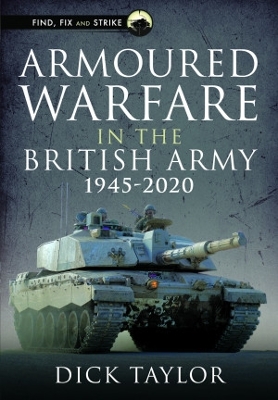Find, Fix and Strike
2 total works
The second volume in Dick Taylor's three-volume illustrated history of the evolution of armoured manoeuvre warfare in the British army covers the period of the Second World War, in which the tank came of age and developed into the principal land weapon of decision. He describes how, during the first half of the war, the British army came close to disaster from the armoured warfare perspective and how the bitter lessons of failure were learned in time to deliver success in 1944 and 1945.
As well as providing a fascinating overview of the tactical use of armour during the main campaigns, he considers such much-neglected aspects as the role of training and organization, officer selection and recruitment, and the mechanization of other arms. His wide-ranging book also features extensive, well-laid-out tables giving key information about British armour during this period.
This expert account quotes heavily from the vivid recollections of soldiers who served in armour, and is not afraid to criticize as well as praise.
As well as providing a fascinating overview of the tactical use of armour during the main campaigns, he considers such much-neglected aspects as the role of training and organization, officer selection and recruitment, and the mechanization of other arms. His wide-ranging book also features extensive, well-laid-out tables giving key information about British armour during this period.
This expert account quotes heavily from the vivid recollections of soldiers who served in armour, and is not afraid to criticize as well as praise.
In this, the third volume in his comprehensive, highly illustrated three-volume history of the evolution of armoured manoeuvre warfare in the British army, Dick Taylor covers the post-war period, up to the present day. He explains how the Royal Armoured Corps contracted rapidly after 1945, then faced the twin challenges of National Service and heavy involvement in numerous wars and campaigns around the globe.
He recounts how the RAC became a fully-professional organization by the early 1960s, and continues the tale of disbandments, down-sizing and amalgamations. In a narrative which is as much a social history as an operational one, the vivid personal accounts of soldiers feature heavily throughout. The story of the Cold War in Germany (BAOR) is told. Then, after the fall of the Berlin Wall, the book describes the role British armour played in conflicts in the Gulf, the Balkans and Afghanistan.
Dick Taylor's thoroughgoing account concludes with an assessment of the�RAC in 2021 in the immediate aftermath of another defence review.
He recounts how the RAC became a fully-professional organization by the early 1960s, and continues the tale of disbandments, down-sizing and amalgamations. In a narrative which is as much a social history as an operational one, the vivid personal accounts of soldiers feature heavily throughout. The story of the Cold War in Germany (BAOR) is told. Then, after the fall of the Berlin Wall, the book describes the role British armour played in conflicts in the Gulf, the Balkans and Afghanistan.
Dick Taylor's thoroughgoing account concludes with an assessment of the�RAC in 2021 in the immediate aftermath of another defence review.

